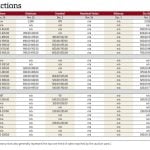Innovation and reinvention are the cornerstones of any industry, helping them survive over the long haul. Their role is crucial in Canada’s agriculture sector. However, sometimes we rely too heavily on insider data knowledge.
This approach can make us stale. It becomes repetitive, eventually costing us our originality and objectivity.
So, where can our agriculture sector and individual farm operations find fresh insights that challenge current assumptions and help us meet the need for innovation and invention.
Read Also

Farmland values: assumptions and realities
Where farmland values are headed and what decisions farmers should make
One way to gain new knowledge and perspectives may be by looking outside of our own industry to see what others are doing.
An argument for doing this comes from the 15th century craftsman Johannes Gutenberg. Until he came on the scene, books had to be laboriously written out by hand, page by page. The idea for his printing press didn’t just come to Gutenberg in a dream, though. He looked to other industries for inspiration. The idea of movable pieces of metal type came from his previous experience as a skilled metalworker, and the large corkscrew press idea was borrowed from wine and olive producers, who used similar machines to extract juice and oil.
Can agriculture still find inspiration for new and advantageous ways to innovate and reinvent?
This time, let’s consider cheese, a household staple since at least Roman times. Cheese is cheese, right? Not much room for reinvention there! At least, that’s what everyone thought up until James Kraft. He believed there was a way to make cheese more shelf stable so that it would last longer — and now, thanks to his innovation, Canadians enjoy 1.7 million of the seven million boxes of Kraft Dinner sold globally each week.
Another successful reinvention/innovation lesson comes from Airbnb, the online marketplace for lodging rentals. Its execs examined not just the travel but also the cinema industry to inspire their unique business model. Now Airbnb can be an inspiration to others, as Jerlin Huang, a creative director and brand manager, writes in his blog: “To reinvent an industry, don’t look directly at that industry. Look at methodical industries.”
Taken together, these three examples offer evidence of the benefits of sourcing outside ideas that can be adapted to address challenges and build strategic advantages inside the agriculture industry. But how? Let’s dig in.
Copycats and trendsetters
In the January 2022 issue of Country Guide, Dr. Simon Somogyi said that “Farming everywhere is a 24/7 job in which people don’t have a lot of time to explore value-added opportunities … We’d love Canada to come up with our own solutions — but it’s so much easier and quicker to copy them and learn from other places.”
To “copy and learn” is simply to research and observe the components of a process, for example, and replicate or modify the parts or wholes that can translate over to your industry or business. Learning in this respect is also about trendspotting and being alert to the weak pulses of change blowing in from the fringes.
“Of course, many industries don’t have research labs per se,” writes Dorie Clark in her book Stand Out: How to Find Your Breakthrough Idea and Build a Following Around It.
“But,” Clark adds, “they all have equivalents — places where new insights are most likely to arise. You may want to track certain think-tanks or universities … Track where the most important advances have come from in the past few years, and you’ll understand who you need to be watching to see what’s coming.”
Estelle Métayer is an expert trendwatcher. In addition to her role as adjunct professor at McGill University and her many board appointments on both sides of the Atlantic (including Agropur), she is the principal and founder of Competia, a consulting firm that helps managers, CEOs and board members build and improve their strategic planning and competitive intelligence function to avoid strategic blindspots.
Métayer points to the power of keeping your finger on the pulse emanating from the future.
“Weak signals are indicators of a change, a trend or an emerging risk that might become significant for the future,” she says.
“They allow us to run hypotheses, expand our thinking and challenge assumptions. How will you interpret those in your industry or field of expertise?”
Clark builds on that insight: “Ask yourself: How have other industries solved this problem? How can you learn more about the techniques they use? Can those strategies be imported into your company or field? What would that look like? What would be easy or hard to fit into the existing culture? How could you tweak the ideas so they’re even more effective?”
Métayer adds, “You’ll want to avoid strategic blindspots, for example, a non-traditional competitor that is leveraging new capabilities which your customer will value more, or a sudden change in consumer behaviour that will represent a massive risk, or worse, a missed business opportunity.”
It’s also important to explore current and emerging policy and social, environmental and technological micro and macro trends that could affect your business and the industry.
“You need to systematically structure an intelligence process to identify the information and data you need to make better informed decisions, to figure out the sources of information you’ll tap into, and how to analyze that information and derive insights,” says Métayer.
Explore, adapt, reinvent
“Those that thrive are quick to read and act on signals of change,” write Martin Reeves and Mike Deimler in Adaptability: The New Competitive Advantage. “They have worked out how to experiment rapidly, frequently and economically — not only with products and services, but also with business models, processes and strategies.”
Here are some approaches to consider:
- We’re told to always compare apples with apples. But what if, as Ozan Varol, author of Think Like a Rocket Scientist suggests, we compare apples and oranges? Looking to dissimilar industries doesn’t mean that you won’t find relevant insights. In fact, the opposite is likely true. You’ll be exposed to solutions and processes that have crossover potential. Varol uses the example of a company designing an internet delivery service that used balloons. The balloons were deflating too quickly, so the project team examined the structure and resiliency of chip bags and sausage casings, “other industries where leaks also matter.” What apples can you compare to your oranges? Where is the crossover potential from another industry to your farm business or the ag industry?
Traditionally, businesses have focused on finding their competitive advantage in “upstream” activities, that is, the material inputs required for production e.g. building bigger operations or sourcing cheaper materials. “But those easily copied sources of advantage are being eroded, and advantage increasingly lies ‘downstream’”, writes Niraj Dawar in “The Shifting Source of Competitive Advantage”. Examples cited in the article include shaping customer perception (e.g. change purchase criteria, build trust); innovation (e.g. tailor your offering to consumption circumstances, reduce customer costs and risks); and building cumulative advantage (e.g. accrue and deploy data).
- Identify your personal, professional and/or industry strengths and weaknesses and use them as a roadmap to pinpoint opportunities that fit your business and drive net gains. Periodically review and renew your skills and capabilities. Where are your emerging vulnerabilities, where is your Achilles heel? “Do not develop optimism bias, thinking that your capabilities are far superior to the ones of your current or future competitors,” says Métayer.
- Bring outsiders in to ask tactical questions about your strategy. This constructive criticism will flag outdated ideas or methods, emphasize weak points, and provide the momentum to manoeuver your business into a better position.
Charles Conn and Robert McLean wrote about taking a “dragonfly-eye view” in their article ‘Six Problem-solving Mindsets for Uncertain Times’. “The idea of a dragonfly eye taking in 360 degrees of perception is an attribute of superforecasters. Think of this as widening the aperture on a problem and viewing it through multiple lenses,” they write. “The secret to developing a dragon-fly eye view is to ‘anchor outside’ rather than inside … Take the broader ecosystem as a starting point. That will encourage you to talk to customers, suppliers, or, better yet, players in a different but related industry.”
As Métayer reminds us, “the electric lightbulb was not invented by continuous improvement of the candle,” but came instead from successive rounds of cumulative reinvention and adaptation from multiple perspectives.
“A revolution in one industry can begin with an idea from another,” writes Varol. “In most cases the fit won’t be perfect, but the mere act of comparing and combining will spark new ways of thinking.”
Canadian agriculture is filled with bright, entrepreneurial minds that are keen to recognize the value of different models and processes in other industries and eager to apply them to our products, methods and business strategies. Keep trends and weak signals on your radar and identify sources of reinvention that can propel your business and the industry forward.
















